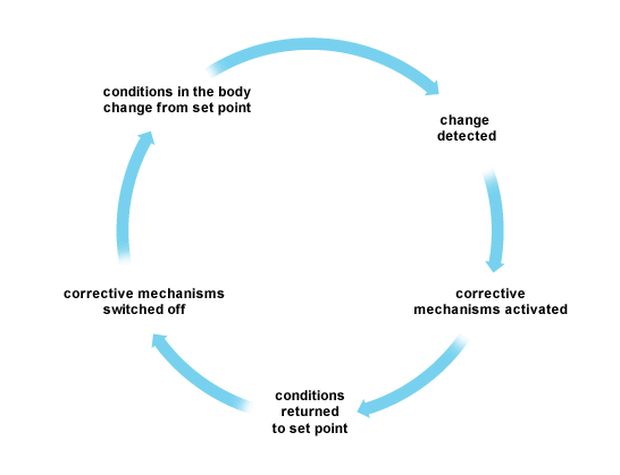Homeostatic control
In the body of an animal conditions such as water concentration, temperature, and glucose concentration must be kept as constant as possible. Control systems that keep such conditions constant are examples of homeostasis; this is the maintenance of constant internal conditions in an organism.
Negative feedback is an important type of control that is found in homeostasis.
A negative feedback control system responds when conditions change from the ideal or set point and returns conditions to this set point. There is a continuous cycle of events in negative feedback.
In the body of an animal conditions such as water concentration, temperature, and glucose concentration must be kept as constant as possible. Control systems that keep such conditions constant are examples of homeostasis; this is the maintenance of constant internal conditions in an organism.
Negative feedback is an important type of control that is found in homeostasis.
A negative feedback control system responds when conditions change from the ideal or set point and returns conditions to this set point. There is a continuous cycle of events in negative feedback.
Stages in negative feedback
An example of negative feedback can be seen in osmoregulation; the control of water concentration in blood and body fluids.
Here are the important facts about osmoregulation:
Here are the important facts about osmoregulation:
- The pituitary gland controls blood water concentration.
- This gland produces the hormoneADH.
- ADH is carried by the blood to the kidneys.
- ADH increases the permeability of the kidney tubules allowing water to be reabsorbed from the tubules into the blood.
- If blood water concentration falls, more water reabsorption is needed so that less water is lost as urine. ADH production is increased.
- If blood water concentration rises, less water reabsorption is needed so that more water is lost as urine. ADH production is decreased.
The cycle of negative feedback
Negative feedback and osmoregulation exam skills
Describing negative feedback
It is important to describe how a change in conditions is detected and how corrective mechanisms return conditions to a set point. A good answer will also point out that the corrective mechanism is then switched off once ADH production has increased to correct a fall in blood water concentration, ADH production is then reduced.
Writing about ADH and osmoregulation
When this appears as an essay question what's important is that you explain the importance of the changes in water concentration of the blood. Don't just use terms like 'water level' in the blood, 'water content' of the blood, or 'amount of water' in the blood.
Remember the key fact that ADH is a hormone that saves water and acts on the kidney tubule.
The process should then be clear:
- its production must increase when blood water concentration falls.
- an increase in ADH production must lead to a reduced volume of urine being produced.
- it must work by increasing water reabsorption from the kidney tubule.


